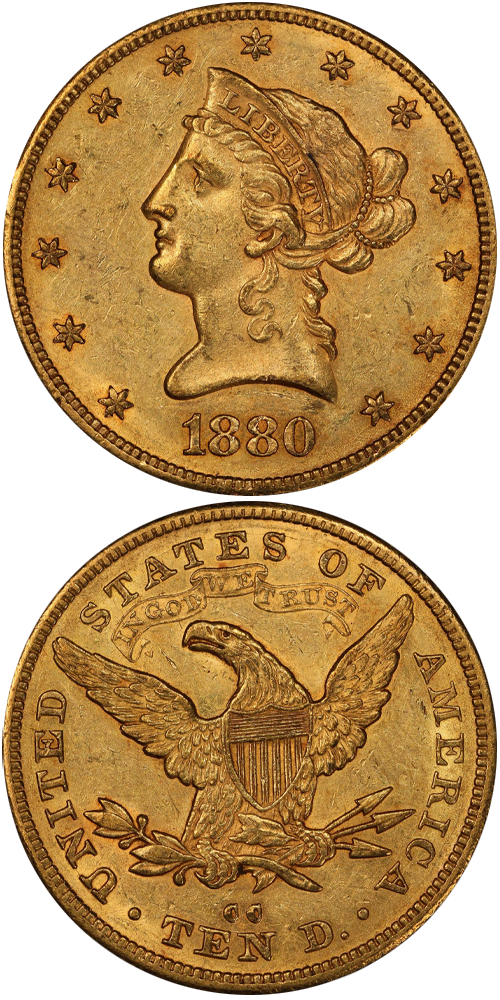1880-CC Liberty Head Eagle
Jeff Ambio: All known 1880-CC eagles were struck from a single obverse die, with the date even and set slightly low. Three reverse dies are known, with Reverse B displaying a small, round CC mintmark. The mintmark is level with the first C mostly above the letter E in TEN and the second C centered over the letter N. This reverse is usually encountered with numerous spindly die cracks contiguous to the peripheral lettering.
Rusty Goe: Things were going badly in Carson City in 1880. The Carson Morning Appeal of April 15, 1880, in reference to the Comstock, said, "everything is down and down low, and 'confidence' is all gone." Unemployment among males had swelled to some 2,000 men, and hundreds left Virginia City monthly. Grant H. Smith has written that the Comstock's demise had broken the hearts of a majority of the people who had staked everything on its continued success. The work stoppage in the Carson Mint's coining department had plodded into its seventh month by April 1880. The Carson Appeal reported about the persistent efforts of Nevada's U.S. Senator John P. Jones and House Representative Rollin M. Daggett to save the Carson Mint and resurrect it from its doldrums. In its May 12, 1880 edition, the Appeal said "Daggett and Jones are hard at work to save the institution, which means the saving of Carson [City]."
Despite the slumping Comstock and resistance in Washington, DC, the Treasury Department reopened the Carson Mint in the first week of May 1880. According to Mint Director Horatio Burchard's 1880 annual report, the Carson branch had limited but sufficient supplies of gold and silver on hand "to authorize the resumption of coinage operations." Coiner Dague struck 2,710 eagles in June. He delivered another 8,480 eagles between July and December. The 11,190 1880-CC eagles coined were the most in one year since 1874. About three percent of that original mintage figure survives today.
Q. David Bowers: Of the 1880-CC eagles struck, Rusty Goe estimates 320 to 360 survive today, with 17 to 25 being Uncirculated. My estimate is 150 to 225 in circulated grades and only a half dozen or so different examples in Mint State. VF is the grade typically seen from old-time holdings (such as pieces found by Thomas L. Elder in the 1930s); those in imports from overseas holdings in the late 20th century tend to be a notch or two higher in grade.
The early auction record, pre-1940, shows Fine and VF, plus at least one Mint State, although we can wonder why it has just "some" original luster: - 1938-03: A.R. Gray and D.P. Dickie Collections (Thomas L. Elder) -- Lot 2752: "1880-CC Uncirculated. Only 11,190 struck, so very rare. Coin has some original luster." Nineteen years ago, when we offered the Stetson University Collection an 1880-CC $10 had this description: Lot 2083: "1880-CC AU-58. Deeply struck and very lustrous. An outstanding example of an issue which is typically seen in significantly lower grades - we point to the EF-40 Miller Sale coin and the similar Eliasberg specimen as examples.
Moreover, David Akers in his 1980 study noted that when seen, the typical coin is apt to be VF or EF, and that when the study was conducted, 1980, he had seen two coins described as Mint State, "Neither of which was especially choice."
The example to the left was sold by Stack's Bowers Galleries in the Fairmont Collection, JBR Set, where it realized $24,000.






